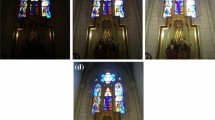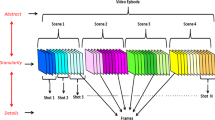Abstract
This paper presents a new convex optimization-based bit allocation framework for video coding. Motivated by the statistical analysis of the relationship between the rate and the corresponding distortion in typical video sequences, an improved empirical rate-distortion model with more flexibility in explaining the experimental observations is proposed. The convexity and monotonicity properties of the proposed model allow us to formulate the bit allocation problem as a convex programming problem, which can be solved using interior-point methods. Coupled with the region of interest (ROI) functionality and the technique of MB classification, the proposed bit allocation scheme is then applied to the problem of frame-level bit allocation for various video coding standards employing motion compensated hybrid DCT/DPCM technique. Similar bit allocation scheme is also developed for MPEG-4 video object coding at the object level. The relevant model parameters are determined using previously encoded data by means of linear regression. Simulation results show that the proposed algorithms can achieve considerably better PSNR performance than the conventional approaches for the tested video sequences, at the expenses of slight increase in coding complexity.





Similar content being viewed by others
References
LeGall, D. (1991). MPEG: a video compression standard for multimedia application. Communications of the ACM, 34, 46–58. doi:10.1145/103085.103090.
Information technology-generic coding of moving pictures and associated audio information: video. ITU-T Rec. H.262-ISO/IEC 13818-2, Nov. 1994.
Video coding for low bit rate communication. ITU-T Rec. H.263, 1996.
Information technology—coding of audio-visual objects—Part 2: Visual. ISO/IEC 14496-2, 2001.
MPEG-4 video verification model v18.0. ISO/IEC JTC1/SC29/WG11 Coding of Moving Pictures and Audio N3908, Pisa, Jan. 2001.
Information technology—coding of audio-visual objects—Part 10: Advanced video coding. ISO/IEC JTC1, 2003.
Test model 5. ISO/IEC JTC1/SC29/WG11, Coding of Moving Pictures and Associated Audio, MPEG, 1994.
Ribas-Corbera, J., & Lei, S. (1999). Rate control in DCT video coding for low-delay communications. IEEE Transactions on Circuits and Systems for Video Technology, 9, 172–185. doi:10.1109/76.744284.
Chiang, T., & Zhang, Y.-Q. (1997). A new rate control scheme using quadratic rate-distortion modeling. IEEE Transactions on Circuits and Systems for Video Technology, 7, 246–250. doi:10.1109/76.554439.
He, Z., & Mitra, S. K. (2001). Low-delay rate control for DCT video coding via ρ-domain source modeling. IEEE Transactions on Circuits and Systems for Video Technology, 11, 928–940. doi:10.1109/76.937431.
He, Z., & Mitra, S. K. (2002). Optimum bit allocation and accurate rate control for video coding via ρ-domain source modeling. IEEE Transactions on Circuits and Systems for Video Technology, 12, 840–849. doi:10.1109/TCSVT.2002.804883.
Lee, H. J., Chiang, T., & Zhang, Y.-Q. (2000). Scalable rate control for MPEG-4 video. IEEE Transactions on Circuits and Systems for Video Technology, 10, 878–894. doi:10.1109/76.867926.
Vetro, A., Sun, H., & Wang, Y. (1999). MPEG-4 rate control for multiple video objects. IEEE Transactions on Circuits and Systems for Video Technology, 9, 186–199. doi:10.1109/76.744285.
Ronda, J. I., Eckert, M., Jaureguizar, F., & Garcia, N. (1999). Rate control and bit allocation for MPEG-4. IEEE Transactions on Circuits and Systems for Video Technology, 9, 1243–1258. doi:10.1109/76.809159.
Chen, Z., Han, J., & Ngan, K. N. (2007). Dynamic bit allocation for multiple video object coding. IEEE Transactions on Multimedia, 8, 1117–1124. doi:10.1109/TMM.2006.884633.
Wu, Q., Chan, S. C. (2005). An improved Macroblock level rate control algorithm for MPEG-4 video object coding. In Proc. of ISPACS, pp. 261–264, Hong Kong, Dec. 2005.
Reininger, R. C., & Gibson, J. D. (1983). Distributions of the two-dimensional DCT coefficients for images. IEEE Transactions on Communications, 31, 835–839. doi:10.1109/TCOM.1983.1095893.
Lam, E. Y., & Goodman, J. W. (2000). A mathematical analysis of the DCT coefficient distributions for images. IEEE Transactions on Image Processing, 9–10, 1661–1666. doi:10.1109/83.869177.
Eude, T., Grisel, R., Cherifi, H., Debrie, R. (1994). On the distribution of the DCT coefficients. In Proc. 1994 IEEE Int. Conf. Acoustics, Speech. Signal Processing, 5, 365–368.
Ding, W., & Liu, B. (1996). Rate control of MPEG video coding and recording by rate–quantization modeling. IEEE Transactions on Circuits and Systems for Video Technology, 6, 12–20. doi:10.1109/76.486416.
Hang, H.-M., & Chen, J.-J. (1997). Source model for transform video coder and its application—Part I: Fundamental theory. IEEE Transactions on Circuits and Systems for Video Technology, 7, 287–298. doi:10.1109/76.564108.
Lin, L. J., & Ortega, A. (1998). Bit-rate control using Piecewise approximated rate-distortion characteristics. IEEE Transactions on Circuits and Systems for Video Technology, 8, 446–459. doi:10.1109/76.709411.
Berger, T. (1984). Rate Distortion Theory. Englewood Cliffs, NJ: Prentice Hall.
Gish, H., & Pierce, J. N. (1968). Asymptotically efficient quantizing. IEEE Transactions on Image Processing, IT-14, 676–683. doi:10.1109/TIT.1968.1054193.
Huang, J. J., & Schultheiss, P. M. (1963). Block quantization of correlated Gaussian random variables. IEEE Transactions on Communications Systems, CS-11, 289–296. doi:10.1109/TCOM.1963.1088759.
Shoham, Y., & Gersho, A. (1988). Efficient bit allocation for an arbitrary set of quantizers. IEEE Transactions on Acoustics, Speech, and Signal Processing, 36, 1445–1453. doi:10.1109/29.90373.
Choi, J., & Park, D. (1994). A stable feedback control of the buffer state using the controlled Langrange multiplier method. IEEE Transactions on Image Processing, 3, 546–558. doi:10.1109/83.334986.
Ramchandran, K., & Vetterli, M. (1994). Rate–distortion optimal fast thresholding with complete JPEG/MPEG decoder compatibility. IEEE Transactions on Image Processing, 3, 700–704. doi:10.1109/83.334973.
Chen, Z., & Ngan, K. N. (2007). Towards rate-distortion tradeoff in real-time color video coding. IEEE Transactions on Circuits and Systems for Video Technology, 17, 158–167. doi:10.1109/TCSVT.2006.888022.
Boyd, S., Vandenberghe, L. (2004) Convex optimization. Cambridge University Press.
Shum, H. Y., Chan, S. C., Kang, S. B. (2006) Image-based rendering. Springer.
Wu, Q., Chan, S. C., Shum, H. Y. (2006) A convex optimization-based frame-level rate control algorithm for motion compensated hybrid DCT/DPCM video coding. In Proc. IEEE Int. Conf. Image Processing, pp. 2469–2472, Oct. 2006.
Wu, Q., Chan, S. C., Shum, H. Y. (2006) A convex optimization based object-level rate control algorithm for MPEG-4 video object coding. In Proc. Asia Pacific Conf. Circuits And Syst. (APCCAS’06), pp. 785–788, Dec. 2006.
Chen, Z., & Ngan, K. N. (2004). Linear rate-distortion models for binary shape in MPEG-4. IEEE Transactions on Circuits and Systems for Video Technology, 14, 869–873.
Lindo Systems Inc. “Lindo API User Manual.” http://www.lindo.com.
Sermadevi, Y., Hemami, S. S., & Masry, M. (2006). Convex programming formulations for rate allocation in video coding. IEEE Transactions on Circuits and Systems for Video Technology, 16(8), 947–959. doi:10.1109/TCSVT.2006.879101.
Author information
Authors and Affiliations
Corresponding author
Additional information
This work was supported by Hong Kong Research Grant Council (RGC). Parts of this work were presented at the conference of 2005 International Symposium on Intelligent Signal Processing and Communications Systems, [16], the conference of 2006 IEEE International Conference on Image Processing [32], and the conference of 2006 IEEE Asia Pacific Conference on Circuit and Systems [33].
Rights and permissions
About this article
Cite this article
Wu, Q., Ng, KT., Chan, SC. et al. Convex Optimization-Based Bit Allocation for Video Coding. J Sign Process Syst Sign Image Video Technol 58, 325–340 (2010). https://doi.org/10.1007/s11265-009-0372-1
Received:
Revised:
Accepted:
Published:
Issue Date:
DOI: https://doi.org/10.1007/s11265-009-0372-1




